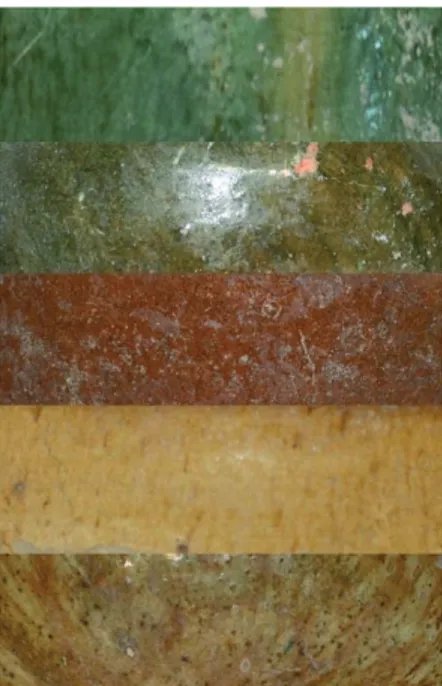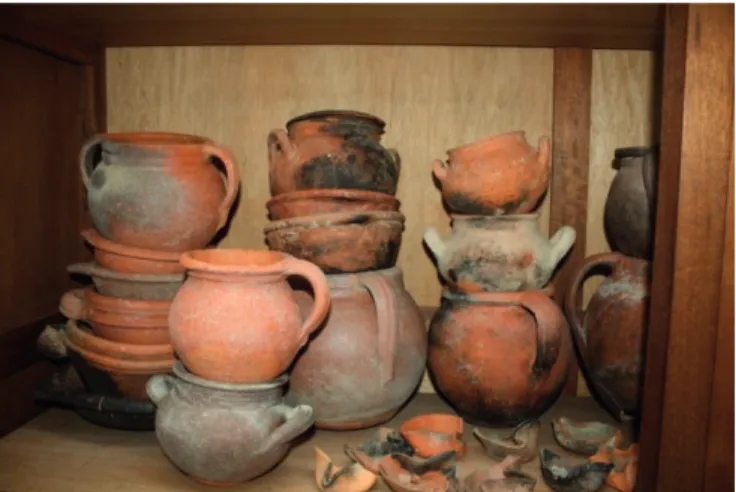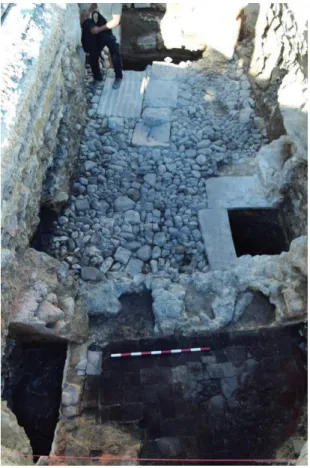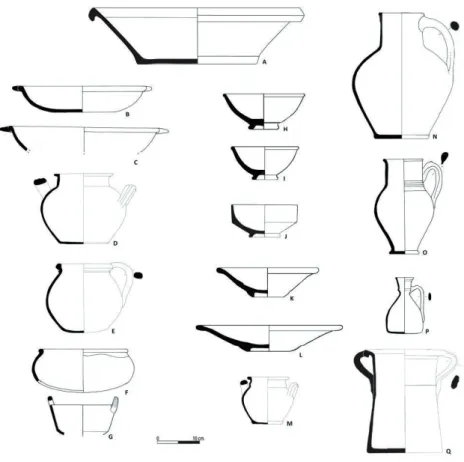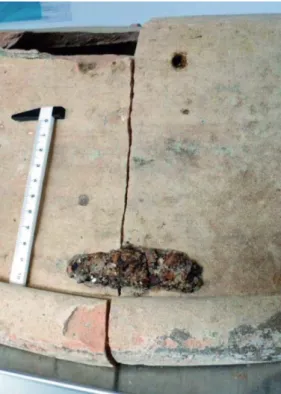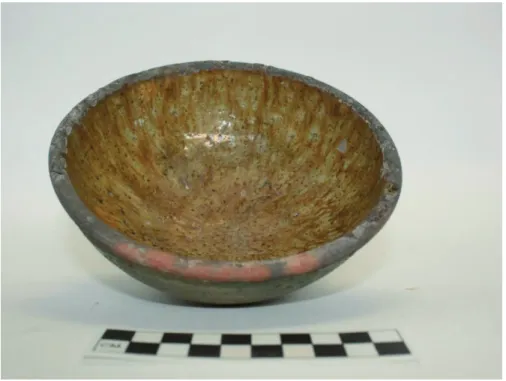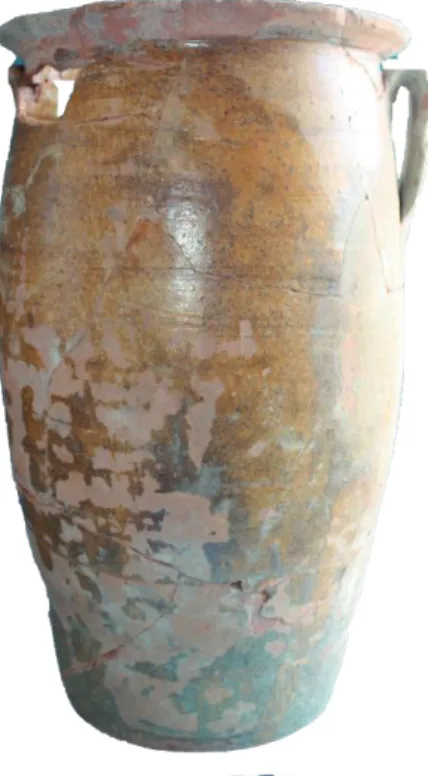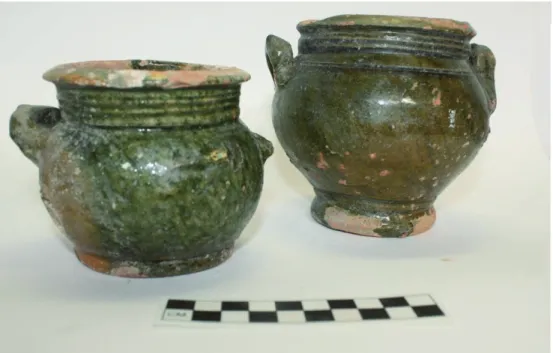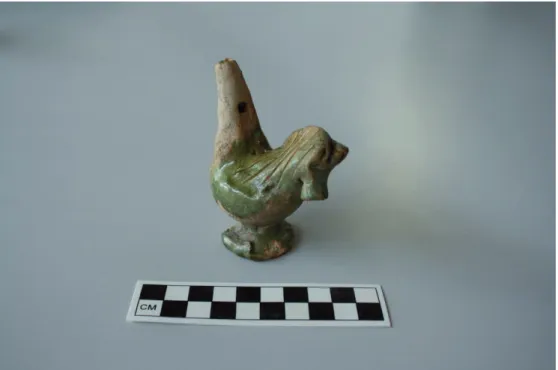International Conference
Glazed Ceramics in Cultural Heritage
Editors
Sílvia Pereira
Marluci Menezes
José Delgado Rodrigues
Edited by Sílvia Pereira, Marluci Menezes & José Delgado Rodrigues
LNEC, Lisbon, 29-30 October, 2018
GlazeArt
2018
International Conference
Glazed Ceramics in Cultural Heritage
Copyright © LABORATÓRIO NACIONAL DE ENGENHARIA CIVIL, I. P. Divisão de Divulgação Cientíica e Técnica
AV DO BRASIL 101 • 1700-066 LISBOA e-e: livraria@lnec.pt
www.lnec.pt
Editor: LNEC
Coleção: Reuniões Nacionais e Internacionais Série: RNI 104
1ª edição: 2018 Tiragem: 100 exemplares
Descriptors: Cultural heritage / Architectural heritage / Glazed ceramics / Azulejo / Ceramic cladding / International congress
Descritores: Património cultural / Património arquitetónico / Cerâmica vidrada / Azulejo / Revestimento cerâmico / / Congresso internacional
CDU 691.4:72.025.2/.4(063)(100) ISBN 978-972-49-2301-7 Legal Notice
The scientiic quality and content of the papers published herein are of the entire responsibility of their authors. Therefore, the publisher accepts no responsibility or liability whatsoever with regard to the information contained in this publication.
The total or partial reproduction, and any representation of the substantial or partial content of the present publication, by any process or means whatsoever, including copy or transfer, without the express consent of the publisher, is prohibited and constitutes an infringement sanctioned by the Law.
Preface
The majolica technique is an Islamic heritage whose technology lowed from the Middle East to Iberia, then to Italy, where it evolved and lowered during the Renaissance, and from there back to Spain and to Antwerp from where it irradiated throughout Europe. In decadence as an art medium in the second half of the 16th century, majolica had a surprising lowering in Portugal precisely at that time
in a particularly demanding avatar as wall linings, and the pillars of the Portuguese predilection for majolica azulejos started being grounded. After a century of evolution through a succession of styles, full linings in cobalt blue over the white tin glaze were again promoted to the status of art in Portugal at the close of the 17th century, when artists started painting and signing azulejo panels masterfully
integrated in the Baroque interiors - maybe the most original Portuguese contribution to the art heritage of Europe.
Movable Italian maiolica art is supremely beautiful but for glazed ceramics to be integrated architecturally, a whole new set of problems materialize. Majolica linings are an artist’s dream and an engineer’s nightmare. A dream because the pigments used to paint them become sealed in glass and potentially forever lasting and shiny; a nightmare because they go against the most basic recommendations an engineer would put forward about a construction material. Laminated materials are problematic because their properties change abruptly, which is always a source of concern for the engineer. But glazed ceramics such as azulejos take that proposition to extremes by lining a very porous ceramic material that tends to expand by absorbing humidity with impermeable glass that does not expand at all and totally cuts the vapour transmission from the wall to the environment. Glazed ceramics for architectural integration are a summit of achievement of try-and-error technology that does not cease to amaze those who dwell into its technical intricacies.
This duality of art content and its material embodiment calls for a co-operation between the Art Historian and the Materials Engineer and that was the ground for the fruitful understanding established in 2009 between the Museu Nacional do Azulejo (the National Azulejo Museum of Portugal) and the Laboratório Nacional de Engenharia Civil (LNEC - the National Laboratory for Civil Engineering) which frames the organization of the present event. The recent project FCT-AzuRe funded by the Portuguese Foundation for Science and Technology involves also the HERCULES Laboratory of the University of Evora and the contributions of ive different specialized approaches that led to the irst scientiic instrumental-based probe into the early establishment of azulejo workshops in Lisbon. Some results of that project will be disclosed in this conference.
The organization is also a joint effort of the European Project IPERION CH and the National Research Infrastructure on cultural heritage E-RIHS.pt that called for a decisive effort from the members of both the Organizing and the Scientiic Committees and to all their members goes our heartfelt thanks. LNEC staff is acknowledged for the local organization and support to the conference. Last but indeed not least, our appreciation goes to all authors whose contributions are the body of the Conference. GlazeArt 2018 follows the successful GlazeArch 2015 and afirms our aim to organize a string of conferences to help expand the network of co-operations towards the understanding and preservation of not only azulejos or majolica, but the whole glazed ceramics heritage.
Organizing Committee
João Manuel Mimoso (LNEC, IPERION CH, FCT-AzuRe) – chair Maria Antónia Pinto de Matos (MNAz) – co-chair
Alexandre Pais (MNAz, FCT-AzuRe) – co-chair Luca Pezzati (CNR, IPERION CH, Italy) Thais Caminha Sanjad (UFPA, LACORE, Brazil) Jaume Coll Conesa (National Ceramic Museum, Spain)
Rosário Salema de Carvalho (Az-Rede / ARTIS – Lisbon University) Antonio Candeias (HERCULES- U. Evora, FCT-AzuRe)
Marluci Menezes (LNEC, IPERION CH) Sílvia Pereira (LNEC, FCT-AzuRe) Dória Costa (LNEC, IPERION CH) M. Augusta Antunes (LNEC, FCT-AzuRe)
Scientific Committee of Reviewers
J. Delgado Rodrigues (LNEC, IPERION CH) – chair Alexandre Pais (MNAz, FCT-AzuRe) – co-chair
Jaume Coll Conesa (National Ceramic Museum, Spain) Thais Caminha Sanjad (UFPA, LACORE, Brazil)
Rosário Salema de Carvalho (Az-Rede / ARTIS – Lisbon University) Kate van Lookeren Campagne (Amsterdam University, The Netherlands) João Manuel Mimoso (LNEC, IPERION CH, FCT-AzuRe)
Marluci Menezes (LNEC, IPERION CH) Sílvia Pereira (LNEC, FCT-AzuRe) Dória Costa (LNEC, IPERION CH) Lurdes Esteves (MNAz, FCT-AZURE)
IV
Index of Full Articles
Signatures and authorial marks on Portuguese azulejos (16th-18th centuries) ... 91
Rosário Salema de Carvalho, Francisco Queiroz
Pottery from Nishapur: Kunstwollen of Iranians ... 110
Anna Kholomeeva
Tiles in the Museum of Civil Engineering ... 116
Alcínia Zita Sampaio
The use of “Tijomel” tiles in Portuguese modern architecture ... 125
Catarina F. M. Geraldes, João Manuel Mimoso, Alexandre Pais
Inluence of the production technology on the morphological characteristics of azulejos ... 140
Sílvia R. M. Pereira, Maria Augusta Antunes, Ana Margarida Cardoso, Mafalda Costa, José Delgado Rodrigues, Maria de Lurdes Esteves, José Mirão, António Candeias, João M. Mimoso
Understanding 17-18th century Dutch tin-glaze through the interpretation and reconstruction
of historical recipes ... 150
Kate van Lookeren Campagne, Luc Megens, Maarten van Bommel
Improving data exploration methods from macro imaging techniques: in situ scanning
macro-XRF investigation on a majolica tile tableau ... 165
Marco Colombo, Stijn Legrand, Geert Van der Snickt, Koen Janssens
Mortars for the reattachment of old tiles: characteristics needed for preservation of azulejos claddings ... 185
Maria do Rosário Veiga
Studies on Azulejo glaze welding by means of laser irradiation ... 194
Sílvia R. M. Pereira, Kostas Hatzigiannakis, Eleni Polychronaki, Kristallia Melessanaki, Paraskevi Pouli and João M. Mimoso
Validation of contactless vibro-acoustic imaging for the detection of glaze delamination in glazed ceramic tiles ... 208
Paola Calicchia, Sara De Simone, Simone Privitera
The implementation of computer-match pigment selection for overcoming metamerism in ceramic glaze reinstatement ... 227
Norman H. Tennent, Isabelle Garachon, James H. Nobbs, Mandy Slager, Bouke de Vries
Biodeterioration of glazed tiles: case studies and novel laboratory-based approaches ... 238
Mathilda L. Coutinho, Ana Z. Miller, Maria Filomena Macedo
A irst approach to the tile collection from the Convento de Santana (Lisbon, Portugal) ... 251
Mariana Almeida, Rosa Varela Gomes, Mário Varela Gomes
Lead glazed ceramics in Lisbon (16th-18th centuries) ... 268
Tânia Manuel Casimiro, José Pedro Henriques, Vanessa Filipe, Carlos Boavida
The 17th-century tile panorama in the island of Santiago, Cabo Verde: a irst approach to
a work in progress ... 283
Mariana Almeida
16th century azulejos what lies beneath the ground of Lisbon? ... 298
Alexandre Pais, Maria José Sequeira, Maria de Jesus Monge, Maria de Lurdes Esteves, Inês Castanheira, António Valongo, Cláudia Manso, Victor Filipe, Ana Margarida Cardoso, João Manuel Mimoso
Conservation and restoration of the tile collection of Quinta Nova, Torres Vedras - Criteria and technique ... 313
Lookouts and outlooks: Lisbon, tiles and topography ... 323
Helena Cunha Lopes, Rui Matos, Joaquim Marcelino Santos
The use of modern azulejos and panels in Portuguese shop fronts ... 337
Catarina F. M. Geraldes, João Manuel Mimoso, Alexandre Pais
No Secret Beyond the Door: the Rampa store and its doorframe, a collaboration between Querubim Lapa and Conceição Silva, 1956 ... 347
Rita Gomes Ferrão
Beneath sacred land: glazed pottery from the old Church of La Concepción in Zamora ... 361
Uxue Sanchez-Garmendia, Estefania Calparsoro, Gorka Arana, Javier G. Iñañez
Villafeliche an 18th century majolica producing village in the heart of Aragon (Spain) ... 380
Javier G. Iñañez
SEM-EDS research on mineral inclusions found in the biscuit of azulejos as a tool for
provenance studies ... 393
João Manuel Mimoso, Dória Rodrigues Costa, Maria Augusta Antunes, Ana Margarida Cardos , Maria de Lurdes Esteves, José Mirão, Alexandre Pais
Apeiron - ᾄπειρον - and Havoc: Beauty in Aalto’s tiles ... 410
Joaquim Marcelino Santos
Chemical Characterization of the glassy phase of glazes from 17th century majolica
azulejos ... 430
Augusta Lima, Carlo Pantano
On the use of glaze and ceramic body analytical spectra in heritage azulejos as beacons of provenance ... 439
João Manuel Mimoso, Maria Augusta Antunes, Sílvia R. M. Pereira, António Candeias, Alexandre Pais
Unknown Porto - the use of azulejos in the modern architecture of the northern
Portuguese town ... 451
Catarina F. M. Geraldes, João Manuel Mimoso, Alexandre Pais
IX International Conference
Glazed Ceramics in Cultural Heritage
Lead glazed ceramics in Lisbon (16th-18th centuries)
Tânia Manuel Casimiro
IHC/IAP-FCSH, AAP, Lisbon, Portugal, tmcasimiro@fcsh.unl.pt
José Pedro Henriques
IAP-FCSH/Cota 80.86, Lisbon, Portugal, jpedro.henriques@gmail.com
Vanessa Filipe
IAP-FCSH/Cota 80.86, Lisbon, Portugal, vanessagfilipe@gmail.com
Carlos Boavida
IAP-FCSH, AAP, Lisbon, Portugal, cmpboavida@gmail.com
SUMMARY: The first documents referring to lead glaze ware production in Lisbon go back to the 16th century with the reference to green glazed pots, mentioned the Lisbon Potter's Regulation. Although no kiln site producing exclusively lead glaze wares was actually found in Lisbon some evidence suggest that these objects may share the same kilns with redware production. The most frequent shapes are large flared bowls, cooking pots, jars, plates and chamber pots, in green and/or yellow, among other forms used in domestic activities. This paper aims to present the types of objects produced by Lisbon potters, discussing production techniques, shapes and function as well as other glazed objects used in Lisbon households based on vessels found in two archaeological excavations in Lisbon, in Carnide and Rossio, reflecting domestic activities from approximately 1580 to 1755.
KEY-WORDS: pottery; lead glaze; green glaze, vessels; domestic consumption
INTRODUCTION
In 1572 the Lisbon Potters’ Regulation divides the craft officials between redware, green glazed, white glazed and roof tile officials (louça vermelha, louça verde vidrada, louça branca vidrada and telheiros). This is one of the first documents in Lisbon mentioning the production of lead glazed wares (Correia, 1926). Older documents are known in other parts of the country such as in Coimbra where a 1556 regulation already mentions the production of lead glaze, calling the craftsman as malagueiros (Carvalho, 1921). Based on archaeological evidence the production and widespread consumption of Lisbon lead glaze may have started during the second half of the 15th century although an earlier production of lead glazed green objects should not be put
aside, considering it may have occurred in other areas of the country, although further evidence is necessary to interpret this possible phenomenon (Ferreira et al., 2016). In the Tagus valley area kilns producing lead glazes have been found at least in Alenquer (Cardoso, et al., 2016), Mata da Machada (Carmona e Santos, 2005) and Santo António da Charneca (Barros et al., 2012). The majority of these findings correspond to 16th century debris areas although an earlier
production could go back to the 15th century.
In some kiln sites in Lisbon, dated from the 15th century, it is not rare to find biscuit fire objects,
possibly indicating that those recipients would be glazed afterwards, nonetheless the presence of lead glazed objects in the kiln wasters is rare and it is impossible to determine if those were produced in that particular kiln or not.
The 1572 document, possibly not the first to be made but the one which survived, can in fact give us important information about craft organization and the importance of lead glaze production. The organization of the lead glazed potters is quite similar to the redware and tin glaze potters. Every year two of the craftsmen were chosen to be the craft judges. The role of these two men were to serve as inspectors making sure that production was controlled and followed the established rules. They actually had to be called every time a kiln was opened after fire so they could check if production was being made as ordered by local authorities. If the craft followed the same rules as the Coimbra craft even the amount of clay and sand would be regulated (Carvalho, 1921). This was actually quite possible considering that the document states that sometimes potters did not produce the pots according to their own regulation, suggesting that each craft might have had its specific documents (irem ver o tal forno se a louça é feita
desenganadamente como lhe manda seu regimento por serem informados que os ditos oleiros muitas vezes fazem a louça de maneira que tanto que a poem no fogo estala assi por ser mal cosida como por ter pouca areia).
All the objects produced in Lisbon had a red micaceous fabric varying from light red (2.5 YR 2/4 MSCC) to dark brown (5YR 5/4 MSCC) in colour. The sherds present a homogenous fabric with small-medium quartz, lime and micaceous inclusions. The pots were all wheel thrown showing rilling marks on the interior surfaces.
One of the main responsibilities of these judges was to examine who was able to become a lead glazed potter by signing a letter. In order to be one any craftsman had to know how to prepare the clay, build the object, prepare the glaze, glaze the recipient and fire it (“Item saberaa
enfornar, vidrar, e cozer”). But he could just not simply acquire the glaze mixture already
prepared since he had to know how to use a small kiln in order to oxidize the lead and transform it into dust (Item saberaa fundir o chumbo en hua fornalha de modo que se faça em poo muito
meudo e se pineire), he also had to learn to grind and sieve the sand (Item saberaa moer a area que se lhe bota e peneirala) and add the right amount of copper oxide to give it a green colour
(Item saberaa deitar lhe o cobre por seu peso). Although no yellow or brown glazes are mentioned in this document they are frequently found in Lisbon domestic environments and sometimes even associated to kiln wasters (Fig. 1). Paste observation makes us conclude that these were also made in Lisbon, thus although the regiment does not mention yellow glazed pottery. These objects are mostly associated to the second half of the 17th century onwards.
This document is also very specific concerning what type of objects the potters had to do in order to pass the exam: alguidares grandes e pequenos (large and small flared bowls), frigideiras (frying pans) and tijellas de fogo (cooking bowls), but also panellas de mea arroba cada hua (large boiling pans) panellas mais pequenas e de toda a sorte (smaller boiling pans) almotolias
grandes e pequenas (large and small bottles), tachos (cooking pots) enfusas de toda a sorte (all
types of jars) pratos de toda a sorte (all types of plates) canos para telhados de cinco palmos (pipes to be used in roofs), malegas grandes que chamão vermelha (large bowls), escudelas de
feição de porcelana (bowls shaped as porcelain) and hu servidor (a pot which could have many
functions including being used as a chamber pot).
The majority of these pots has a direct translation into the archaeological record and these were the shapes that Lisbon inhabitants were using when using lead glazed pottery in their daily activities.
However, there are other documents that can actually help to understand what were these glazed pots used for. Inventories, letters and especially recipe books mention the used of glazed pots in many different functions especially cooking, storing and serving. Whenever those documents provide information about the function of these recipients they will be mentioned.
269
Full Articles
International Conference
Glazed Ceramics in Cultural Heritage
Fig. 1: Different glaze colours from ceramics recovered in Lisbon
The objective of this paper is to present the lead glaze artefacts found in two sites in the Lisbon area, one in Carnide and the other in Rossio square, and try to connect those shapes with the forms mentioned in the potters’ regiment, discussing their use in the domestic activities of everyday lives. The different chronologies of both sites permit an overall perspective on what type of lead glazed objects were being used in domestic environments during the Early Modern Age in Lisbon.
Lead glaze pottery is frequent in early modern archaeological sites in Lisbon, however, it is still difficult to understand in what amounts. The quantity present in archaeological contexts has many variations related to chronology, type of site and even site formation. These were the issues which the authors had in mind when selecting the sites.
The sites
The excavation of an area in order to replace sewer systems and general refurbish of a city square in Carnide lead to the discovery of more than one hundred medieval storage pits transformed into dumpsters in the 16th and 17th centuries (1550-1650 approx.) (Fig. 2) (Caessa and Mota,
2014). These reflect the daily use of ceramics and other material culture elements used by that population in what can already be considered a rural area, although associated to important religious houses. Literally thousands of objects, in different stages of conservation, were found inside those abandoned storage pits (Fig. 3). Unfortunately, it was not yet possible to study this collection entirely, meaning that we are not yet able to provide a definitive number of all the ceramics found on site. Some studies are being made. Chinese and European imports and some daily ceramics were already published (Casimiro, Boavida and Moço, 2017; Casimiro, Boavida and Detry, 2017) and painted redwares and tin glazes are in preparation to publish soon.
Fig. 2: Carnide excavation (after Caessa and Mota, 2014)
Fig. 3: Carnide cooking pots
In Carnide, glazed and tin glazed objects, either imported or produced in Portugal, correspond approximately to two thousand recipients. In spite of this large number this does not correspond to more than 10% of the overall collection thus unglazed ceramics seem to correspond to around 90%. The conclusions related to these numbers must bear in mind social and economic background of that population and always aware that this is a dumpster site and reflects the use of ceramics for almost a century in an area in the outskirts of the city. These numbers although corresponding to what people consumed in their households does not mark a specific moment in time and can only be used to state a consumption tendency.
Most of the lead glazed ceramics correspond to recipients used to store, serve and prepare food. No evidence of glazed cooking pots was identified, what in fact can be explained by the amount of unglazed vessels. In fact, boiling pans and frying pans, with no surface treatment or burnished inside are the highest amount of finds together with drinking cups. When analysing the lead glazed ceramics thoroughly we are aware that not all of them present the same fabrics, thus
271
Full Articles
International Conference
Glazed Ceramics in Cultural Heritage
produced in different areas and possibly not all of them made in Lisbon, with similarities with the finds from Alenquer and Santo António da Charneca (Cardoso, et al., 2016; Barros et al., 2012).
As for the other site an excavation made in the summer of 2017 discovered the remains of a house destroyed on the morning of 1 November 1755, located on the edge of a building’s block in the southwest area of the Rossio square. Three compartments were excavated, including an inner yard (Fig. 4). The structures were well preserved on the level floor and while the yard, a private area with a direct exit to a main street and a water well, had a cobbled floor the other two were covered with red floor tiles. One of these inner compartments seems to have been used as a kitchen. The typology of its construction with a well, a tank with the walls covered in tiles, and the material culture found inside, including a knife on the floor and a redware pot close to the well, used as a water container, suggests this use.
Fig. 4: Rossio excavation
The other compartment has no especial feature that would help us recognize its use, however the abundance of objects inside, some of them large storage vases in situ, may indicate its use as a pantry or storage area. This site is extraordinary since we are able to understand what type of lead glazed wares were in use in that particular house, in one particular moment. This is a perfect site to study the consumption of glazed pottery in the mid-18th century Lisbon considering that
all the objects found were in used the day that house was destroyed. Once again the conclusions made about the pottery found here have to bear in mind that this was located in one of the richest
areas of the city and the type of ceramics found inside suggest a wealthy social background (Casimiro, et al., in press). Green glazed boiling pans and frying pans correspond to the majority of the kitchen ware, although unglazed objects were also in use. That being said the majority of the cooking ware was actually glazed and corresponded to 21% of the overall collection which indicates a clear increase when compared to the Carnide collection. A large complete storage pot, yellow glazed was found in situ and possible used as a container for organic domestic garbage.
The objects
Alguidares (Fig. 5A) are among the most frequent lead glazed objects found in Early Modern
Portuguese archaeological contexts, and one of the form potters had to know how to do to pass their exam. These have oblique walls, flat bases and everted rims. The inner surface of these robust objects was most of times covered with green or yellow lead glaze although unglazed and burnished objects are occasionally found. Fabric observation reveals that not all of them were made in the same place and several origins have to be considered. In the Carnide excavation red paste alguidares were found covered with green and yellow lead glaze as well as objects with light buff sandy fabrics suggesting a southern Spanish Andalusian production. As for the Rossio excavation only three fragments were found, one green and two yellow glazed.
Fig. 5: Glazed objects found in Carnide and Rossio
273
Full Articles
International Conference
Glazed Ceramics in Cultural Heritage
These were among the most versatile objects in use in any Lisbon dwelling and a true multifunctional object. In the Livro de Cozinha de D. Maria, a recipes book written somewhere in mid-16th century these are used to wash fresh cut quinces (“alguidar de agua fria para
colocar marmelos aparados”) (Manupella and Arnaut, 1967: 87). In another recipes book by Luís de Távora, written around the same time, the alguidar is used to knead dough in several
recipes (Barros, 2016). However, these were not only used in the kitchen. In the Livro de Contas
de D. Catarina (1571), there is a reference to two glazed objects used in the pharmacy
(alguidares vidrados para a botica - 140rs”) (Cândido, 2013, 186). Although we have no reference to the size of these objects (and the regiment mentions different size alguidares) in late 16th century two of these objects cost 140 reis, which would be a considerable price at that time.
Adding to this there are several archaeological examples of repaired alguidares with several iron staples revealing that the price of the object justified the time spent in its repair (Boavida, 2017:1824 (Fig. 6).
Fig. 6: Repairs in a large green glazed alguidar
Although the 1572 document mentions frigideiras (frying pans) and tijellas de fogo (cooking bowls) we found no evidence of these glazed objects in the Carnide excavation (all of them were unglazed) although a few of them were in use in the Rossio house (Fig. 5 B-C). These were hemispherical recipients with a flat base and straight walls with different sizes some of them with small triangular handles glazed on both surfaces. In the Livro de Cozinha de D. Maria, these pots are mentioned frequently when referring to food which needed to be fried or taken into the oven. In the book Arte da Cozinha (1680) the recipient which is used to fry food also goes into the oven in the preparation of Queijo com Lombo de Porco (Rodrigues, 1693: 5).
Boiling pots (panelas) were used in all different sizes especially with the intent of boiling food. Although shapes tend to slightly vary during the Early Modern Age, especially in rims and handles its shape is quite consistent. A globular body with a short narrow neck sits on a flat base (Fig. 5 D-E), a shape shared by glazed and unglazed pots, though most of them are only glazed on the inside. These are in fact among the most frequent references in cook books and some of the recipes have names such as Olla podrida still using the medieval name for cooking pot, possibly copied from the Spanish (Rodrigues, 1693). These pans were used to cook food for long hours in a low fire which could be directly over the house’s hearth or using a brazier.
Food was also cooked inside tachos. In Carnide although hundreds of tachos were discovered none of them had its walls glazed. Once again the Rossio house had a few of these in use at the time it collapsed (Fig. 5 F-G). These were green lead glazed in both surfaces with a hemispherical shape and flat base and two or four handles. These objects are frequently mentioned in the documentation used to stew food. In the Livro de Cozinha da Infanta D. Maria bone marrow is cooked inside these recipients (Gomes, 1996). A note should be made mentioning that in spite of the potential of these recipe books in pottery studies a portion of the mentioned objects may have been made of copper or iron, although metal cooking pots are rare in archaeological contexts, possibly related to their recycling characteristics.
In spite of the number of lead glazed objects used in food preparation and cooking most of them were used to serve food and to eat from. Potters had to learn to do plates (pratos) of all types. The presence of these objects in the archaeological record is frequent although their shapes change considerably from the 16th to the 18th century. While in older sites these have a
trunco-conical shaped objects with a recessed bottom (Fig. 5 K-L), in the 17th and 18th centuries these
are going to evolve to large plates with a ring foot, covered with white tin glaze. While they correspond to a large portion of table ware in the early stage of their production latter these are going to be replaced by tin glazed white objects decorated with blue motifs. Several documents mention the used of plates to eat from or to serve food at the table suggesting these had different sizes.
Bowls (malegas or tigelas) with or without handles were also frequently used, some of them imitating the shapes of exogenous objects such as Chinese imports. Their shapes are quite variable and they could be trunco-conical carinated bowls with a ring foot, or hemispherical ones also with a ring foot (Fig 5 H-I). These could have different coloured glazes in its surfaces such as green outside and white inside or green and yellow, although the most recurrent are covered in and out with the same colour glaze (Figs 7 and 8). Bowls are among the most variable and culturally influenced forms. In the 16th century these were carinated reproducing the shapes
produced in southern Spain which endured from the Muslim period. When the Portuguese reach the Indian Ocean and porcelain starts to invade daily lives in Portugal, and in addition to the traditional trunco-conical shape, the hemispherical shape, similar to porcelain, starts to be largely produced and both are going to coexist at least until mid-17th century. These were used to eat
from directly and individually or to serve food. In the several recipes from the Arte de Cozinha (1680) a book by Domingos Rodrigues food is served in tigelinhas and covilhetes (small glazed bowls) while many other dishes are served in normal plates (Rodrigues 1693: 144).
Water containers were preferably done in non-glazed ceramics so the process of evaporation could maintain the water fresh and cold. However occasionally there are some recipients which were glazed either in both surfaces or just in their outer surface which were used to contain liquids including water, or most regularly wine. The potter’s regiment mentions enfusas de toda
a sorte, this is, all types of jars. An enfusa is usually interpret as a one handle jar with our without
a spout in a lobed rim with a flat or ring foot base (Fig.5 N-O). However, other types of jars or bottles were also made such as almotolias grandes e pequenas (large and small bottles). These could be used as containers for several liquids and would serve at the table to contain water, wine
275
Full Articles
International Conference
Glazed Ceramics in Cultural Heritage
or even olive oil or vinegar. They are small recipients with one handle, a narrow neck and globular body (Fig. 5 P).
Fig. 7: Bowl (tigela) found in Carnide
Finally the potters’ regiment mentions that in order to get their letter of craft the potter had to demonstrate to the judges he knew how to make a servidor (Fig. 5 Q and 9) . This is actually one of the most difficult objects to understand what was used for. It is generally recognized in the archaeological literature that this pot would have the function of a chamber pot or piss pot, nevertheless it is difficult to state if this was in fact the case. Large and robust pots with flat bottoms and a wide rims with two handles, glazed on both surfaces are usually said to serve this function (Figs. 4). They are recovered with different sizes suggesting that different sized people used them and are very frequent in the archaeological contexts from 15th to early 18th century
when they start to be replaced by small sized tin glazed white chamber pots. However, these could actually have different uses inside the household and serve other functions. In the Rossio house, in the room recognized as a storage area, there was one of such large vessels (Fig. 9) which could have been used as a pot to gather some of the domestic garbage.
Fig. 9: Yellow glazed pot found in Rossio
Outside the category of domestic used vessels, the regiment also mentions that potters had to know how to make canos para telhados de cinco palmos (pipes to be used in roofs), possible with the objective of draining water. None of the collections recovered either in Carnide or Rossio has any glazed pipes, in spite of the large number of roof tiles found both contexts. However, a fragment of a green glazed pipe found in Loulé and interpret as a gargoyle with serpents could in fact correspond to such object (Oliveira and Gomes-Martínez, 2017: 614-616). Other objects which were not mentioned in the potters’ regulation were constantly produced by Lisbon potters and regularly found in the archaeological record or mentioned in other documents.
277
Full Articles
International Conference
Glazed Ceramics in Cultural Heritage
In the 1507 inventory of Beatriz mother of King Manuel, there are references to green glazed pots to contain sweets and other foods. Archaeologically these are found constantly. Small green glazed pots with a flat base and two handles and even a rilled rim so a string could be passed along the neck so a cloth could cover the sweets (Fig. 10) are believed to fulfil this function. In the Livro de Receitas da Infanta D. Maria this cloth is often mention as a cover (recipe 89). This preservation solution is seen in many Josefa d’Óbidos paintings (Serrão, 1991).
Fig. 10: Green glazed pots found in Carnide
In 18th century Lisbon wealthy contexts is frequent to find a type of green glazed pottery
decorated with human faces of small children or woman. This was found in a type of burner in the Marialva palace (Marques and Fernandes, 2006), in a lid in the Cadaval Palace (Casimiro, Almeida and Barbosa, in press) and in another lid in the Rossio house. We are not yet sure if these were made in Portugal or imported however they seem to mark some sort of fashion item in mid-18th century high society since these were never found in less wealthy contexts excavated
in the city or its surroundings (Casimiro, 2011; Casimiro et al. in press).
Among the most interesting glazed objects found in 16th and 17th century contexts are
zoomorphic whistles shaped as horses with or without a rider (Fig. 11). The identification of a fragment of one of these artefacts in the excavation of a kiln area in Alenquer (Cardoso et al., 2016) may indicate they were being produced outside Lisbon though highly consumed by Lisbon populations. These were found covered with green and yellow lead glazes. These are usually interpreted as toys (Gomes, Gomes and Casimiro, in press) since they only purpose was to make noise.
Fig. 11: Green glazed whistle found in Carnide
DISCUSSION
The purpose of this paper was to discuss the production and consumption of lead glazed ceramics in Lisbon domestic environments in Early Modern age. Since no pottery kiln specifically producing lead glazes was ever found this study has to be based in the archaeological remains obtained which resulted from domestic activities.
The majority of the finds has the surface covered with green glaze. Could this be related to the availability of raw-materials? Were green glazed objects more resistant or was it just a tendency of Portuguese consumers to use such colour in objects?
Associating form with function is always a difficult task. Although the majority of recipients are easy to interpret and a cooking pot was destined to boil, fry or stew food, presenting different shapes, an alguidar was a multifunctional object and it is hard to specify what such objects were used for or what type of liquids were kept inside an almotolia. However, it is our objective at least to start a discussion on the importance that lead glazed objects had in the overall domestic consumption of lead glazed ceramics.
On the other hand, we should also try to understand how did people reacted to these objects. Were they seen exactly the same way as non-glazed objects? How did people felt when food was served or eaten in a yellow or green glazed bowl? Would they prefer it instead of a redware plate or bowl or even a tin glaze plate? All of these objects share the archaeological context thus all of them were used by the same population. What would make people prefer ones instead of the others? Would food look more appealing inside a yellow or a white plate? Would that make any difference at all?
The first major conclusion while analysing a late 16th /early 17th century context and comparing
it to a mid-18th century household is that the consumption of lead glazes seems to intensively
change during two centuries. While in the earlier context lead glaze is almost exclusively
279
Full Articles
International Conference
Glazed Ceramics in Cultural Heritage
associated to table ware and small storage in the mid-18th century context the majority of the
lead glaze ceramics is associated to kitchen ware with several cooking pots presenting an interior and sometimes exterior green glaze. Glazed objects continue to be used as tableware although lead glaze is clearly replaced by white tin glaze plates and, for the wealthier groups, porcelain. The origin of objects also changes over time. While in the earlier contexts the observation of the objects’ body reveals a wide range of origins, most of them believed to be produced in the wider region of Lisbon with objects possibly made in Alenquer and the Barreiro area, in the 18th century
all the glazed objects seem to be produced locally. The change in these consumption patterns may have motivated the end of several workshops and kilns abandonment in late 16th century,
especially with the introduction of white tin glazes massively produced in Lisbon.
Except for the large alguidares and possibly the highly decorated objects found in the 18th
century wealthy contexts there is no other evidence of imports outside the Tagus area or local workshop productions. These were clearly expensive objects and the type which was not thrown away easily based on the evidence of repairs in several of them.
Except for the glazed pipes used in roofs all the objects mentioned in the potters’ regiments can be associated to forms recovered from the Lisbon archaeological record, although potters should be free to vary the shapes. Nevertheless, there are some forms found which do not have a specific association with the mentioned forms, thus potters could actually manufactured everything demanded by the local population, such as all sorts of pots and even ceramic toys.
The number of glazed wares is very variable according to the social and economic background of the population and in some contexts associated to less wealthy social groups in mid-18th
century the number of glazed ceramics is rather small when compared to wealthy households indicating that these were not cheap objects (Casimiro et al., in press).
CONCLUSION
Glazed wares are a constant presence in all post medieval archaeological contexts since at least late 15th century. However, the amounts of their presence are quite variable. Not many excavations have a full account of all the ceramics found on site, however the ones who have it demonstrate that lead glazes are never the majority of ceramics, a role which is occupied by unglazed redwares. Most of the times they are not even the majority of glazed wares and from mid-16th century onwards tin glaze wares start to occupy that top place.
The type of glazed ceramics is also variable and while in the 16th and 17th century they are mostly
related to table wares with plates and bowls occupying the leading role two hundred years later the majority of lead glazed ceramic is used in food preparation.
When analysing numbers, we should also have in mind that each site corresponds to a specific social and economic background and not all of them can be interpreted the same way. Wealthy sites consume high quality products and the number of glazed wares, based in the available evidence seems to be higher in wealthier contexts, possibly indicating that these were more expensive than non-glazed objects.
Unfortunately, it is not easy to understand the value of objects in early modern Lisbon and except for a few documents there are no references to these daily wares. Nevertheless, a major conclusion has to be drawn and lead glazed ceramics, although in different amounts, were present in poor and rich homes.
Bibliographic references
BARROS, A. L. (coord.). As receitas de cozinha de um frade Português do século XVI. Coimbra: Imprensa da Universidade de Coimbra, Coimbra, 2016.
BARROS, L.; BATALHA, L.; CARDOSO, G.; GONZALEZ, A. A Olaria Renascentista de Santo António da Charneca - Barreiro, In TEIXEIRA, A.; BETEENCOURT, Velhos e Novos
Mundos. Estudos de Arqueologia Moderna, Centro de História de Além-Mar, Lisbon, 2012, pp.
699-710.
BOAVIDA, C. Dos objectos inúteis, perdidos ou esquecidos. Os artefactos metálicos do Largo do Coreto (Carnide, Lisboa), in ARNAUD, J. M.; MARTINS, A. Arqueologia em Portugal 2017 – Estado da Questão, Associação dos Arqueólogos Portugueses, Lisboa, 2017, pp. 1821-1834. CAESSA, A.; MOTA, N. O núcleo histórico de Carnide: o contributo da investigação arqueológica, In Veiga, C. M.; Reis, M. F (coord.) Quadros da História de Lisboa. A Freguesia
de Carnide, Academia Portuguesa de História e Junta de Freguesia de Carnide, Lisboa, 2014, pp.
85-104.
CÂNDIDO, G. Comer como uma Rainha. Estudo de um livro da Casa de D. Catarina de Áustria. Unpublished PhD dissertation, Faculdade de Letras da Universidade de Coimbra, Coimbra, 2014 CARDOSO, G.GOMES, J:; , RODRIGUES, S.; BATALHA, L. A produção oleira renascentista na bacia hidrográfica do baixo Tejo, Al-Madan Online. IIª Série, 2016, 20 (2), pp. 54-63. CARMONA, R.; SANTOS, C. Olaria da Mata da Machada: Cerâmica dos Séculos XV e XVI, Câmara Municipal do Barreiro, Barreiro, 2005.
CARVALHO, A. T. A Cerâmica Coimbrã no século XVI, Imprensa de Universidade, Coimbra, 1921.
CASIMIRO, T. M. Estudo de espólio de habitação setecentista em Lisboa, O Arqueológo
Português, S.5, nr. 1, 2011, pp. 689-726.
CASIMIRO, T.M.; ALMEIDA, M.; BARBOSA, T.M. Largo Duque do Cadaval. Evidências uma catástrofe, In GOMES, M.V.; CASIMIRO, T.M.; BOAVIDA, C. Terramoto de Lisboa.
Arqueologia e História, Associação Arqueólogos Portugueses. Lisbom , in press
CASIMIRO, T.M.; BOAVIDA, C.; DETRY, C. Cozinhar e comer: cerâmicas e alimentação em Carnide (1550-1650), In Actas do Encontro Diz-me o que comes... Alimentação antes e depois da
cidade, Centro Arqueologia de Lisboa, Lisbon, 2017, pp. 105-116.
CASIMIRO, T.M.; BOAVIDA, C.; MOÇO, A. Louça “de fora” em Carnide (1550-1625). Estudo do consumo de cerâmica importada, In Actas do I Encontro de Arqueologia de Lisboa Uma
Cidade em Escavação, Centro Arqueologia de Lisboa, Lisbon, 2017, pp. 56-67.
CASIMIRO, T.M.; HENRIQUES, J.P.; FILIPE, V.; RAMOS, D. Pottery consumption in 18th century Lisbon. In Europa Post-Medievalis. Post-medieval pottery between (its) borders. Archaeopress, Oxford, in press.
CORREIA, V. Livro dos Regimẽtos dos officiaes mecânicos da mui nobre e sẽpre leal cidade de
Lixboa (1572), Imprensa da Universidade, Coimbra, 1926.
MANUPPELA,G.; ARNAUT, S. (Eds) Livro (O) de Cozinha" da Infanta D. Maria de Portugal, Imprensa da Universidade, Coimbra, 1967
MARQUES, A.; FERNANDES, L. Palácio dos Marqueses de Marialva. Intervenção Arqueológica na Praça Luís de Camões (Lisboa, 1999-2000). Património Estudos, 9, 2006, pp. 195-206.
FERREIRA, L.F.V.; GOMES, M.V.; PEREIRA, M.; SANTOS, F.; MACHADO, I. A multi-technique study for the spectroscopic characterization of the ceramics from Santa Maria do
281
Full Articles
International Conference
Glazed Ceramics in Cultural Heritage
Castelo church (Torres Novas, Portugal), Journal of Archaeological Science: reports, vol. 6, 2016, pp. 182-189.
GOMES, P. O livro de cozinha da Infanta D. Maria, Olaria, 1, pp. 93-104.
GOMES, M.V.; GOMES, R.V.; CASIMIRO, T.M., Ceramic toys and miniatures from the 16th
-18th centuries found in Lisbon, In Europa Post-Medievalis. Post-medieval pottery between (its)
borders. Archaeopress, Oxford, in press.
OLIVEIRA, L.F.; GOMES-MARTINEZ, S. Gárgula com serpentes. Séculos. XIV-XVI. In CARVALHO, A.; COITO, L.; ALMEIDA, R.; TOUREIRO, S. (coord.) Loulé. Territórios, memórias, identidades” Lisboa/Loulé: MNA; MMLoulé; INCM, 2017, p. 614.
RODRIGUES, D. Arte de cozinha devidida em tres partes, a primeyra tratta do... Officina de Manoel Lopes Ferreyra, Lisboa, 1693
AV DO BRASIL 101 • 1700-066 LISBOA • PORTUGAL tel. (+351) 21 844 30 00 • fax (+351) 21 844 30 11 lnec@lnec.pt www.lnec.pt
ISBN 978-972-49-2301-7
